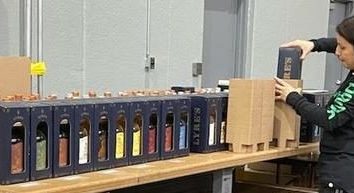By LM Staff September 11, 2023
Much like the freight environment has become highly commoditized in recent years, the pallet industry is now operating more like a commodity, with significant peaks and valleys that impact both availability and pricing.
“When we were creating PalletTrader, I told everyone involved that this business is just as good in an up market as it is in a down market,” says John Vaccaro, president of Bettaway Supply Chain Services and PalletTrader.

“In a tight market, you’re looking for capacity. You can’t find enough trucks or pallets. You don’t know where to get them, and your line or your DC is going to shut down as a result,” says Vaccaro. “In a down market, it’s about streamlining internal operations and using more automation for tenders, payments, reporting and other activities.”
For the corporate users looking to create efficiencies and cut costs in a down market, PalletTrader helps streamlines process, provides market intelligence, and expands their network of suppliers to ensure optimal purchasing/pricing.
While similar benefits apply to the smaller operations, PalletTrader also serves as an extension of their company—offering sales and procurement support—in lieu of scaling their own internal operations.
In this Insider Q&A, Vaccaro digs into the current pallet environment and how the need for a change prompted him to open an online marketplace that provides a full round of benefits for pallet buyers and sellers nationwide.
Q: What challenges and marketplace shifts are keeping pallet buyers and sellers up at night right now?
Vaccaro: Right now, pallet value is collapsing rapidly. It’s a completely different environment from just one year ago. Like many other commodities, there’s a supply and demand component at work here.
Pallet managers were challenged when the cost of pallets went up extremely rapidly, and now they’re being challenged as those prices come down. For example, pallet depots are being flooded with pallets; some are offering pallets at less than cost just to offload that inventory.
“There was no transportation management system [TMS] for pallets, and I knew that if I didn’t create this type of platform, someone else would. That would probably disrupt my business, so I decided to become the disruptor.”
Right now, pallet valuations are coming back down to pre-pandemic levels. As the supply chain finally starts to empty out and organizations resize their inventories, it’s creating a flood of used pallets back into the market.
The problem is that pallets are used in a “fenced-in” manner—when they come back, they fill up the depot’s yard pretty quickly. And once the yard is filled, the pallets have to be sold or liquidated just as fast. Once you’re out of space, you’re out of space.
Q: What drove you to start PalletTrader?
Vaccaro: The logistics space has been disrupted by technology tremendously over the last 20 years. With the advent of the internet came online bids, marketplaces, the DAT index, the CASS index, load boards, plus many other innovations.
For every truck or container, there’s probably a pallet underneath every shipment, yet none of the technology advancements were taking place in the pallet space. We were dealing with 500 pallet depots, and a lot of the business transactions were still phone calls, e-mails and even some faxes. There was no common transaction platform or system integration at all.
If you want to do a freight bid right now, you can either sign up online or use a platform that puts you instantly in touch with hundreds of carriers [or, post a load]. This convenience didn’t exist with pallets, and we saw an opportunity to fill that market gap.
The bottom line is, our customers were hungry for a system that allowed them to control things themselves. These were scenarios where they could identify and offer pallet loads to a new provider, but still keep their incumbents. Or, a scenario where they needed refreshed pricing but didn’t have the access or systems to do it efficiently or effectively.
“We spent the two years of lockdown creating wireframes, coding and marketing. The more we got into it, the more we realized what a great, untapped opportunity was standing right in front of us.”
This made me realize that you couldn’t actually procure pallets online with any level of scale or process. Of course. there may have been some pallets for sale on eBay, Amazon or Uline, but there wasn’t a portal, system or marketplace for searching, bidding, buying, transacting or selling pallets.
There was no transportation management system [TMS] for pallets, and I knew that if I didn’t create this type of platform, someone else would. That would probably disrupt my business, so I decided to become the disruptor.
Q: Can you walk us through how PalletTrader works and tell us about the technology behind it?
Vaccaro: PalletTrader is a place to buy and sell pallets. We didn’t want to just open it up as a “free marketplace” because the pallet business is very B2B; we wanted to be able to vet the buyers and the sellers that were using it.
So, people have to sign up in order to use the platform. Once we’ve collected a few key pieces of information, we validate the new users and give them access to the marketplace (this is a very simple process/turn around, versus the traditional hours/days of implementation).
Once they’re in the marketplace, their experience is very customizable—from notifications, to search parameters, to automated functionalities—and the user is in control. Users can “buy” and/or “sell” pallets. On the buy side, users can search pallet inventories by geographic regions, by type, grade, quantities and so forth.
The platform will detect the user’s location, and based on their search criteria, PalletTrader will match and present the best inventory options and current prices. In some cases, users can buy-it-now [BIN] for a specified price listed, or the individual can submit a bid/makes an offer on the pallet posting.
A buyer can also post a need (i.e., a special size, spec of pallets, or regular volume quantities, that they don’t see offered in inventory). It’s similar to sites like Craigslist or eBay, where someone could create a post that says: “This is what I want to buy, in these quantities and at this frequency.”
For the sellers, PalletTrader provides an instant e-commerce site that requires no additional development. Sellers can instantly create an online store and post all of their different pallet offerings and reach the world on a platform where buyers and sellers come together.
Q: How is PalletTrader helping to modernize pallet management?
Vaccaro: We already had long-term relationships with hundreds of pallet depots, and I consider PalletTrader to be somewhat of an “Uber” model, through which we give single operators greater opportunities in the bigger market.
A lot of pallet depots are smaller, family-owned operations that were facing much industry consolidation and looking to serve more—and larger—customers. I put the two together: the customers who wanted an easier way to buy and sell pallets, and then the pallet depots themselves.
Looking at the opportunity, there were clearly two potential paths. The first was to become the largest pallet broker online—kind of the C.H. Robinson of pallets, if you will. Then the other model was to actually become the platform.
With the latter, we would effectively be the conduit, similar to an Amazon, eBay or other site that brings together buyers and sellers and winds up lifting the entire industry as a result. That was the path we chose to take.
Q: You launched PalletTrader smack in the middle of the global pandemic. How did that go for you?
Vaccaro: Well, I’ve always felt like the best time to be innovative or creative is during a downturn or recession, when nearly everyone else is standing still. That’s really what happened during COVID; a lot of companies locked down and basically went into hiding.
On the other hand, we spent the two years of lockdown creating wireframes, coding and marketing. The more we got into it, the more we realized what a great, untapped opportunity was standing right in front of us.
Q: What other benefits can buyers and sellers expect from using the platform?
Vaccaro: PalletTrader is not just a marketplace, it’s also a pallet management system. For the large company with multiple sites that they want to bring together, our platform basically serves as a free pallet management system.
The site also features private groups for businesses, which protects and keeps private information like who the incumbents are, how much a company is paying for a pallet and/or who their customers are.
For customers who have their own incumbent providers, or who don’t want to transact in the public sphere, these are private groups just like you would see on LinkedIn or Facebook. This gives companies a safe and secure way to tender pallet loads to their pallet providers. Users can acknowledge receipt, pay for the pallets or use auto-tender, and that all happens “behind the curtain.”
Q: Have buyers and sellers embraced your new pallet trading platform?
Vaccaro: Since October, we’ve transacted about 800,000 pallets and we’ll hit one million by August, which is a great milestone. We worked hard to get the sellers onboard before the buyers, because as we developed it, we knew we were dealing with a “chicken and egg” scenario: what comes first, the buyers or the sellers?
The feeling was if we attracted buyers and there were no sellers, then we wouldn’t have anything to sell. To avoid this problem, we put a lot of effort into getting the pallet industry involved and those efforts have really paid off.
The feedback we’ve received from users mostly centers on how flawless the system has been and the ease of use. Other companies have told us that they want to integrate the platform into their own pallet-trading environment, so right now we’re developing some open application programming interface (API) sources that will enable even more integration.
Finally, the all-new PalletTrader Plus will launch in June. Once in place, this new offering will allow customers to hand over their tenders/needs to us, we will create the bids, manage, and operate the platform for them; think of it as managed services.
Read More


